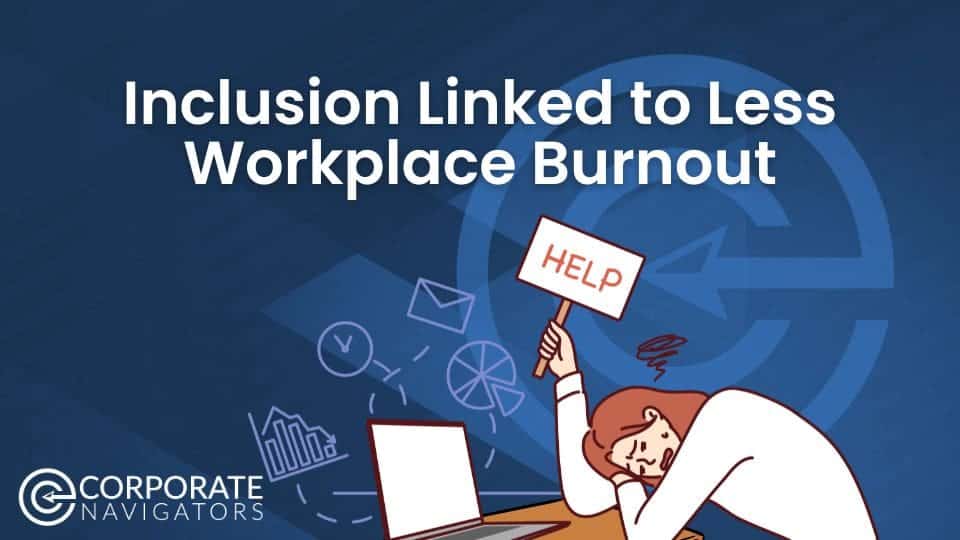
Table of Contents
Is Inclusion the Answer to Combat Employee Burnout?
As we head toward 2025, more organizations are focusing on the holistic workplace, which includes more investment in diversity, equity, and inclusion (DEI) and brand image.
This ever stronger pull toward prioritizing these aspects of business are tied to the younger working generations’ preference to choose companies that have a good brand image and robust DEI initiatives. (See more in our 2025 Recruitment Trends Report.)
However, there is another strong case for focusing on rectifying disparities in the workplace and making it a more inclusive place: less burnout. According to a report by Spring Health, 76% of workers in America are currently experiencing workplace burnout.
Traditionally, burnout has been chalked up to being a byproduct of high stress and long hours. However, a recent report from Boston Consulting Group has also found connections between burnout and low feelings of inclusion.
So, in addition to addressing key issues like long work hours, companies should take initiatives to resolve inequities in the workplace by investing more in DEI efforts.
We’ve also had the pleasure of obtaining the expert insights of Javier Barrientos, Chief DEI Officer at Point123 Health and our President Mitch Golob regarding inclusion’s positive impact on the workplace.
What Does Inclusion Look Like in the Workplace?
In the context of the workplace, inclusion means creating an environment where everyone feels valued, respected, and able to contribute, regardless of their background or identity.
Fostering an inclusive environment is highly beneficial to organizations because it reduces feelings of burnout and brings in diverse backgrounds and experiences. An inclusive workplace often has these characteristics:
1. Diverse Representation of People & Experiences
Ensure that the workforce reflects a range of perspectives, experiences, and identities to help people of different national origins and beliefs feel a sense of belonging. Other categories to consider include race, gender, age, sexual orientation, physical ability, veteran status, and other underrepresented people.
2. Equal Opportunities
Provide fair access to resources, career advancement, and professional development for all employees. This can also involve addressing and removing barriers that might disadvantage certain groups so everyone can be active participants.
3. Respect and Value
Create a culture where diverse perspectives are acknowledged and valued. This means leaders actively consider different viewpoints and experiences in their decision-making.
4. Supportive Environment
Implementing policies and practices that support diverse talent, such as equal access to facilities, flexible work arrangements, and anti-discrimination measures. In this environment, employees feel comfortable expressing their true selves without fear of retribution.
Diversity, equity & inclusion goes beyond mere representation but it focuses on ensuring that every individual feels integrated and engaged in the workplace culture. When everyone has the opportunity to thrive, organizations can reach their full potential.
Diversity, Equity, and Inclusion in Recruitment: Mitch Golob’s Perspective
More organizations are understanding the importance of having a diverse and inclusive workplace. At Corporate Navigators, we have also helped clients identify diverse candidates that could enrich a workplace.
Speaking to this, our President Mitch Golob says, “Many clients come to us to identify underrepresented talent because they understand that diversity in hiring leads to an inclusive work culture. This strengthens the company’s reputation, creating more opportunities for everyone, and leads to productive and creative results.”
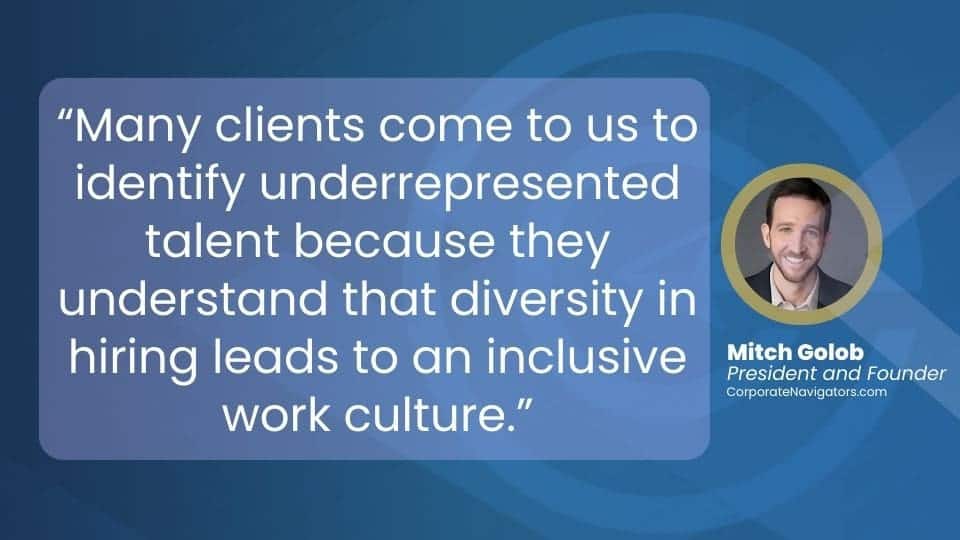
DEI and Its Essential Role in Today’s Workplace: Javier Barrientos
In addition to Mitch Golob’s insights, we also connected with Javier Barrientos, Chief Diversity, Equity, and Inclusion officer at Point123Health. Since fostering an equitable, diverse, and inclusive workplace is his primary focus, he had plenty to share about the benefits of having a diverse and inclusive workplace. Here are his words.
How DEI impacts employee morale and retention
“A lot of data shows that a predominant amount of employees want to work in places where diversity is a consideration, where people are included, and feel like they belong. Gen Z, which is quickly repopulating the workforce, is especially interested in DEI in the workplace. It’s become an expectation in the American workforce.
“DEI delivers that fairness they are looking for. It benefits everyone because it brings innovation, better decision making, creates an element of fairness in the workplace regarding pay equity, benefits, even as fundamental as promotions and growth opportunities.
“So from many angles, DEI is here to stay. I know in the media there is currently a backlash against DEI, but in reality, what we hear from our employees is quite different. People are still very committed and expect a fair inclusive workplace where they can belong.
The most effective types of DEI initiatives in the workplace
“DEI initiatives are the most effective when you tackle them on the individual, team, to organizational level. You have to do all three things for it to work. Everyone is diverse. Everyone has a unique story and background. There is never going to be another person like you. The diversity of every person is important.
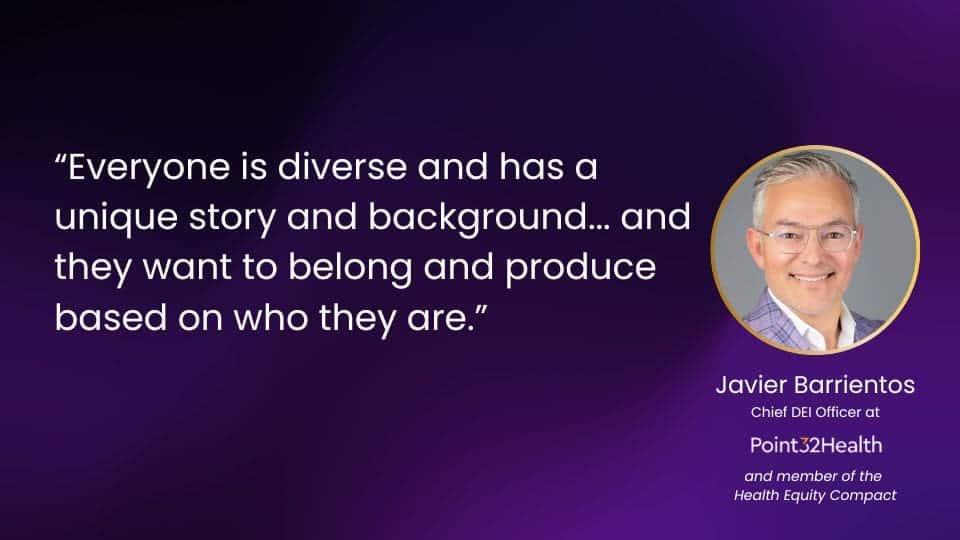
You want to belong and produce based on who you are. When you’re comfortable in your own skin, you can thrive. However, it’s not all about one person either, but it’s bringing this mix of backgrounds in a team together. Managing that diversity with others and acting in an inclusive manner releases the power of the whole team.
“At the organizational level, you have to change the system and practices. Just because an individual or a team changes doesn’t mean the organization changes as a whole. If a team is inclusive, it can’t change the fact that the company building doesn’t have a ramp to make it accessible for wheelchair users.
“Changing the system on the macrolevel will enable a rich mix of people to be more productive and engaged together. What’s effective is when you see efforts on all three levels. All three (Corporate, Teams, and Individuals) have to be synergistically aligned and in motion to create a most positive and productive environment that we all seek.
To companies on the fence about integrating DEI initiatives:
“If you are serious about your business in the long run, you have to think about DEI because it addresses a lot of the strategic challenges and competitiveness a business needs to have to succeed.
“Today’s demographics in the U.S. are only getting more diverse. If you need to tap into talent, you need to tap into the whole diversity of the labor market. You can’t just count on one form of talent. You need innovation and we know from research that a rich mix of backgrounds and perspectives give you that.
“If you surround yourself with people just like you, you may be heading for the cliff faster. DEI will be a net gain for businesses. People who see differences and understand them are better leaders and managers and better at attracting opportunities and at generating better solutions.
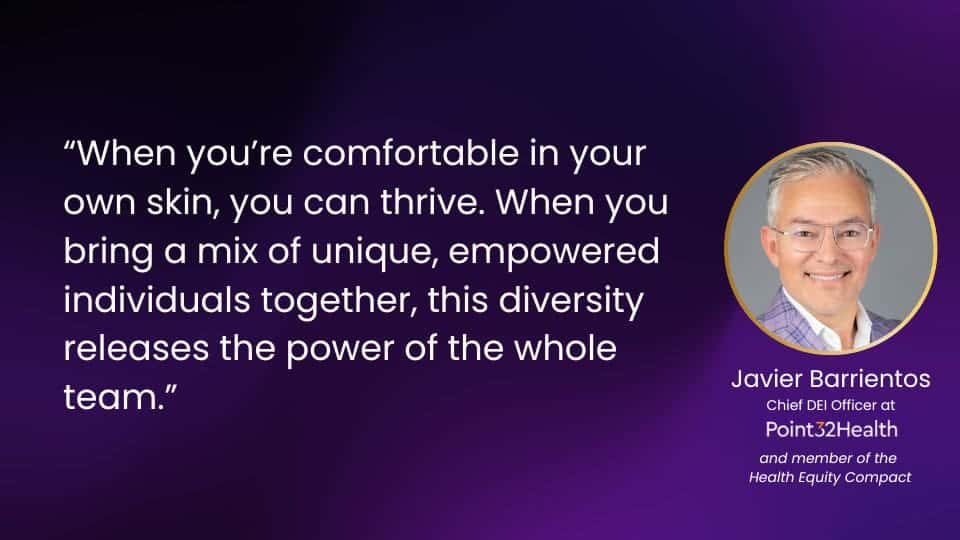
“The opposite is also true. First of all, there is considerable risk. It is illegal to discriminate. There will also be morale issues and a negative cycle associated with lack of DEI. If you want a positive culture and cycle for your business, internal staff, consumers, and suppliers, there is no way around it… you need DEI.
“If you, as a leader or company, don’t have DEI skills, ignore the detractors… you need to gain it fast to optimize performance. You and your company stand to gain more and create better outcomes with an inclusive approach.”
Thank you, Javier, for your amazing insights!
Burnout and Its Link to Low Inclusivity
As stated previously, low feelings of inclusion have been connected to burnout in a recent study. Essentially, employees who are burned out are also less likely to feel included at work.
How to address high burnout and low inclusion? Merely hiring a diverse workforce is not enough. Retention of these individuals is key through creating a work culture that supports them. Specifically, a survey by Boston Consulting Group revealed four sentiments that have the greatest impact on employees’ overall sense of inclusion:
- Good Access to Resources
- Support from Senior Management
- Psychological Safety with Direct Manager
- Fair Treatment and Equal Opportunity for Success
By rectifying these core areas in the workplace, organizations can create an environment where demographic and cultural diversity thrive, reducing the chances of employees, especially of marginalized socioeconomic status, experiencing burnout.
Fixing the Burnout Problem
According to BCG, there are actionable ways to improve all four aspects of an inclusive workplace. Therefore, if you need a good place to start making a better environment for all your employees, start with these four tips:
1. Enact Inclusive Policies and Practices
Creating an inclusive culture begins with enacting official policies that the company must follow. Your company handbook should have guidelines for a fair hiring process, equitable pay, and zero tolerance for any type of implicit bias.
The rules should align to make it a safe place for everyone. Setting these rules in place creates a foundation upon which a truly inclusive workplace is built.
2. Make Leaders Commit to Inclusivity
Leaders must lead by example. Simply advocating for inclusion isn’t enough, but they need to embody inclusive values.
Leaders also need to be held accountable by unbiased third parties like HR who can intervene and ensure employees are treated fairly. Overall, actions speak louder than words, so leaders who actively support an inclusive environment will set a positive tone for the entire organization.
3. Increase Employee Engagement & Respect Feedback
Companies must create an environment where feedback is actively encouraged and acknowledged. Engagement really drives the bus when it comes to developing employees and retaining them.
It’s not enough to simply have a seat at the table; but it’s crucial that every voice is heard. Employees who feel heard are more likely to be engaged and offer their best even when others aren’t looking.
4. Foster a Culture of Belonging
Belonging is a natural byproduct of inclusion. It’s the sense that your presence is valued and your unique contributions are acknowledged. Picture a workplace where everyone, from entry-level personnel to the C-suite, feels a deep sense of ownership and are proud of their work.
That’s the kind of culture you should strive to create. This can be done in a variety of ways, such as recognizing achievements, giving out bonuses, crediting people for their ideas, and promoting talented individuals.
- Bonus Tip: Making a work culture that prioritizes mental health can also have positive impacts on inclusiveness. An APA survey discovered that 81% of employees will look for workplaces that support mental health while exploring future jobs. Having provisions in place for mental health can be the secret sauce to attracting a talented new hire!
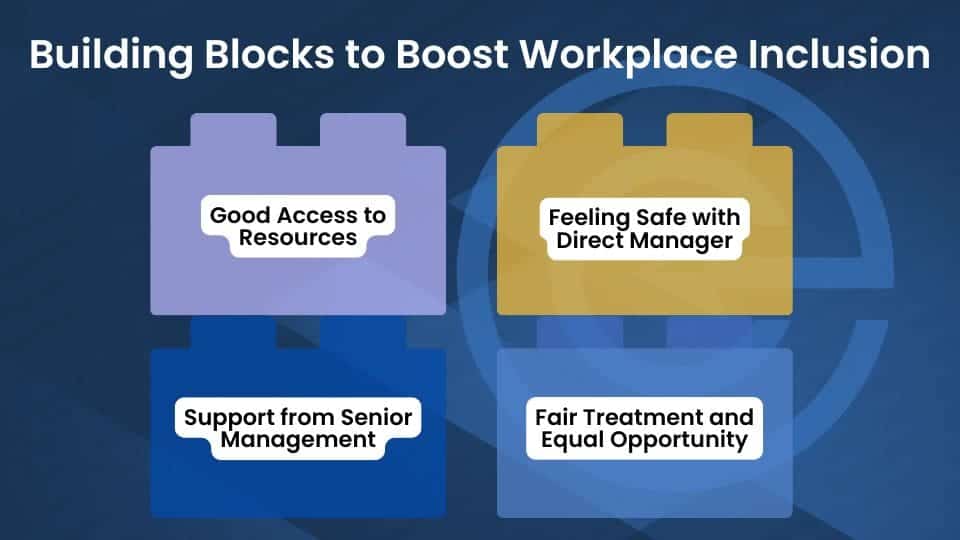
The Financial Cost of Burnout
According to a Gallup study, burned-out employees are 2.6 times more likely to be looking for another job. In addition, another report by Gallup and Workhuman discovered turnover and lost productivity from burnout cost businesses around $322 Billion globally. Within this figure, burnout-triggered turnover costs companies 15-20% of their payroll budget each year.
Not only are burned out employees more likely to leave the workplace, but they are more likely to experience poorer health. To support this, APA reports reveal that employees who experience workplace burnout are:
- 57% more likely to be absent from work.
- 180% more likely to develop depressive disorders.
- 84% more at risk to get Type 2 diabetes.
- 40% more likely to have hypertension.
Unhealthy, stressed employees also cost companies more money in high health insurance claims and decreased productivity. In Marsh McLennan Agency’s Employee Health and Benefits Trends Report, health inequities are projected to cost companies $42 Billion per year in productivity loss, and if left unaddressed, this figure will rise to $1 Trillion by the year 2040.
So fostering a healthy, happy workplace isn’t just a good thing to do for people, but it’s a profitable investment for any organization!
What are the symptoms of workplace burnout?
Workplace burnout can be defined as a state of chronic stress and exhaustion attributed to prolonged work-related pressure. The symptoms can affect one’s physical health, mental well-being, and overall job performance. Here are some common symptoms:
- Physical: Fatigue, insomnia, headaches, gastrointestinal issues, and muscle tension and aches.
- Emotional: Overwhelm, irritability, detachment, and lack of enthusiasm.
- Mental: Difficulty in focusing, memory problems, and feeling not valuable.
- Behavioral: Withdrawal from work-related activities and social interactions, frequent absenteeism, and reduced efficiency.
- Interpersonal: Conflict with colleagues and lack of empathy.
Recognizing these symptoms early and taking steps to address them, such as seeking support, setting boundaries, and improving work-life balance, is crucial to managing and mitigating burnout.
The Importance of Inclusion in the Workplace
Burnout is a productivity killer that drains your top talent. And unfortunately, it’s all too common. Thankfully, companies can prevent a fair amount of burnout by creating an inclusive workplace. Since burnout is linked to lack of inclusivity, fixing this vital part of your company culture can have long-lasting holistic benefits.
If you need help sourcing a diverse talent pool, we can help you at Corporate Navigators. Our talented team of researchers can identify qualified candidates that match your search criteria so you can create a team that has a lot to offer!


